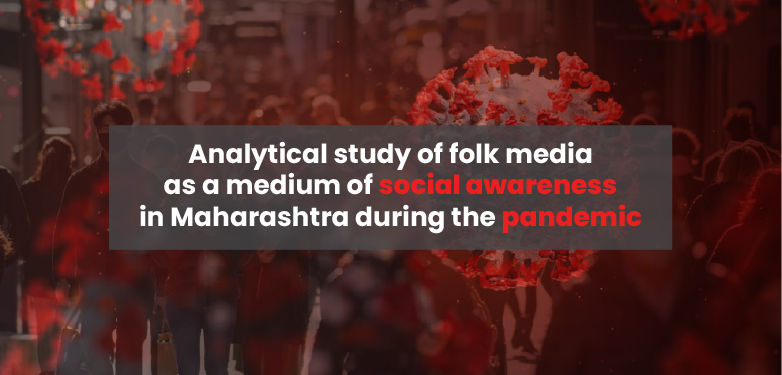Analytical study of folk media as a medium of social awareness in Maharashtra during the pandemic
While Folk Art has always remained an important aspect of culture and community, folk-lore or oral communication has always believed to be the primary education. In this era of changing forms of media with advent of digital platforms and social media, an analytical study was carried during the Pandemic in April 2020 to identify the use of folk media, one primary mode of communication during the new age media. Samples were collected of various folk artistes in Maharashtra who composed and also performed folk songs including the content of Covid 19 and precautionary measures to be taken and how songs included social awareness topics. It was identified that most of the songs composed by keeping the tradition of folk arts alive, was also shared on social media. Though the folk artistes used the new media platform of social media, still the core values of folk arts remained uncompromised.


While many individuals endured challenges during the Covid-19 pandemic, professionals faced unique struggles. Among them were performing folk artists, whose entire income relied on live programs. With the implementation of lockdowns lasting for more than two years, these programs were canceled. Despite the period of hardship, performing folk artists continued their commitment to social awareness through their performances.
In this endeavor, the artists embraced digital platforms, ensuring that their message resonated through their traditional art form. The efforts of performing artists in Maharashtra, in particular, inspired me to investigate how they employed their traditional art form to promote social awareness during the Covid-19 pandemic while preserving the essence of their cultural heritage.
In the wake of the unprecedented global pandemic, the study of folk media messages during Covid-19 in India has emerged as a compelling and vital area of research for me. The multifaceted nature of this crisis has not only challenged the healthcare system but has also had profound socio-cultural implications. As the virus spread rapidly, communities across India turned to their traditional forms of communication to disseminate information, share coping mechanisms, and foster a sense of solidarity. Recognizing the significant role that folk media plays in shaping cultural narratives, I am motivated to delve into this subject to understand how these messages have influenced public perceptions, behavior, and responses during such a critical period.
India, with its diverse cultural landscape, is home to a rich tapestry of folk media that includes oral traditions, folk songs, street theater, and various forms of visual storytelling. In times of crisis, these cultural expressions become powerful tools for communication, often transcending linguistic and educational barriers. My motivation to study folk media messages during the Covid-19 pandemic is rooted in the belief that examining these indigenous communication channels will offer unique insights into the ways communities navigate uncertainty, disseminate vital information, and construct narratives of resilience. This research is not only an academic pursuit but also a recognition of the intrinsic value of traditional forms of communication in times of crisis. Considering the emphasis of communication, I was motivated to study the messages shared in the performing arts like Bharud, Gondhal, Kirtan in Maharashtra. The folk artistes in Maharashtra kept their tradition in the performing arts alive and try and changed the messages to spread the awareness. Simple messages like washing hands regularly, using masks and sanitizers were imbibed in the performing arts. The same performances then were shared across the digital platforms like YouTube and their Facebook page. This way it was easier for them to reach their audience, keep their performing arts alive and also to spread the awareness.
The Covid-19 pandemic has underscored the need for effective communication strategies to ensure public understanding and cooperation. Folk media, deeply ingrained in the fabric of Indian society, has played a crucial role in disseminating information about preventive measures, debunking myths, and providing a cultural context to the unfolding crisis. The study aims to explore how these messages have been crafted, adapted, and disseminated across diverse regions, considering the cultural nuances that influence the reception and impact of such messages. By focusing on folk media, I hope to contribute to the development of more culturally sensitive and contextually relevant communication strategies for future health crises.
Moreover, studying folk media messages during the pandemic is an exploration of the adaptive nature of culture in the face of adversity. It allows me to investigate how communities draw upon their cultural heritage to make sense of a global health crisis. The narratives embedded in folk media messages provide a lens through which one can examine the collective consciousness of a society during a period of upheaval. Understanding the ways in which traditional forms of expression evolve and respond to contemporary challenges is essential for preserving cultural identity and fostering resilience in the face of unforeseen circumstances.
Use the link to read full research paper: https://bit.ly/4c6Y3uK


CATEGORIES
- Data Science and Analytics
- Cloud Computing
- Data Analytics and Business Intelligence
- AI and Digital Systems
- Cyber Security and Digital Forensics
- Business Analytics & Intelligence
- Banking & Financial Services
- International Business
- Digital Marketing
- Research Paper
- Media & Entertainment
- Media Management
- Journalism and Media Production
- Media & Information Technology
- Visual Communication
- Game Development
- Sound Engineering
- Game Art & Design
- Photography
- Film Making
- Animation & VFX
Are you aspiring to become a proficient Media or Technology professional?
Look no further; we are committed to nurturing the potential of young minds. Are you ready to enhance your skills?


